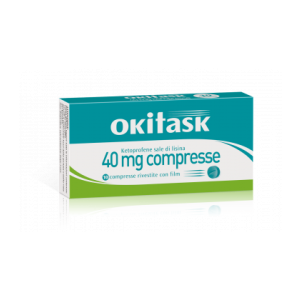Ship in Europe, Find out rates!
Okitask 40 mg Ketoprofen Lysine Salt 10 Coated Tablets

- box Delivery in Italy in 24/48 and free returns
- star3.000+ positive reviews
- dropboxOver 60,000 products in the catalog
Tablets based on Ketoprofen lysine salt .
Therapeutic indications
Okitask is used for the treatment of pain of various origins and nature, and in particular: headache, toothache, neuralgia, menstrual pain, muscle and bone pain.
Dosage and Posology
Take according to the following doses:
- Adults and children over 15 years: 1 tablet, in a single dose, or repeated 2-3 times a day, in the painful forms of greater intensity.
Do not exceed the recommended doses: in particular elderly patients should follow the minimum dosages indicated above. The duration of the therapy must be limited to the overcoming of the painful episode.
How to use
It is preferable to take the product on a full stomach.
Overdose
Cases of overdose have been reported with doses up to 2.5 g of ketoprofen. In most cases, the symptoms observed were benign and limited to lethargy, drowsiness, headache, dizziness, confusion and loss of consciousness, as well as pain, nausea, vomiting, epigastric pain. Gastrointestinal bleeding, hypotension, respiratory depression and cyanosis can also occur. There is no specific antidote to ketoprofen overdose. In case of suspected massive overdose, gastric lavage is recommended and symptomatic and supportive treatment should be instituted to compensate for dehydration, monitor urinary excretion and correct acidosis, if present. In cases of kidney failure, hemodialysis can be helpful in removing the drug from the bloodstream
Contraindications
- Hypersensitivity to the active substance or to any of the excipients;
- History of hypersensitivity reactions such as bronchospasm, asthma attacks, acute rhinitis, urticaria, skin rashes or other allergic-type reactions to ketoprofen, or to substances with a similar mechanism of action (for example acetylsalicylic acid or other NSAIDs;
- Severe, rarely fatal, anaphylactic reactions have been observed in these patients;
- Third trimester of pregnancy, known or suspected pregnancy, during lactation and in children under 15 years; severe heart failure
- Gastric or duodenal ulcer, gastritis and chronic dyspepsia;
- Subjects with leukopenia or thrombocytopenia, with ongoing bleeding or haemorrhagic diathesis, undergoing treatment with anticoagulants;
- Severe renal or hepatic insufficiency;
- Patients undergoing major surgery;
- Active peptic ulcer / haemorrhage or history of recurrent peptic ulcer / haemorrhage (two or more distinct episodes of proven ulceration or haemorrhage);
- Previous history of gastrointestinal bleeding, ulceration or perforation related to previous NSAID treatment
Side effects
Gastrointestinal system: the most commonly observed adverse events are gastrointestinal in nature. Peptic ulcers, gastrointestinal perforation or bleeding, sometimes fatal, may occur, particularly in the elderly. The frequency and extent of these effects are significantly reduced by taking the medicine on a full stomach. In exceptional cases, the manifestations of hypersensitivity can take the character of severe systemic reactions (edema of the larynx, edema of the glottis, dyspnoea, palpitation) up to anaphylactic shock. In these cases, immediate medical assistance is required. Classification of expected frequencies: Very common (1/10), common (1/100 to ≤1 / 10), uncommon (1/1000 to ≤1 / 100), rare (1/10000 to ≤1 / 1000), very rare (≤1 / 10000), not known (cannot be estimated from the available data). The following adverse reactions have been observed with the use of ketoprofen in adults:
- Disorders of the blood and lymphatic system
- Rare: haemorrhagic anemia
- Not known: thrombocytopenia, agranulocytosis, hypoplasia, bone marrow failure
- Disorders of the immune system
- Not known: anaphylactic reactions (including shock), hypersensitivity
- Psychiatric disorders
- Not known: mood changes
- Nervous system disorders
- Uncommon: headache, dizziness, somnolence,
- Rare: paraesthesia
- Not known: convulsions, dysgeusia
- Eye disorders
- Rare: blurred vision
- Ear and labyrinth disorders
- Rare: tinnitus
- Cardiac pathologies
- Not known: heart failure
- Vascular pathologies
- Not known: hypertension, vasodilation
- Respiratory, thoracic and mediastinal disorders
- Rare: asthma
- Not known: bronchospasm (especially in patients with known hypersensitivity to acetylsalicylic acid and other NSAIDs), rhinitis, dyspnoea, larynx edema, glottal edema.
- Gastrointestinal disorders
- Common: dyspepsia, nausea, abdominal pain, vomiting
- Uncommon: constipation, diarrhea, flatulence, gastritis
- Rare: stomatitis, peptic ulcer
- Not known: exacerbation of colitis and Crohn's disease, gastrointestinal haemorrhage and perforation, ulcerative stomatitis, melaena, haematemesis, duodenal ulcer and perforation
- Hepatobiliary disorders
- Rare: hepatitis, increased transaminases, elevated serum bilirubin levels due to liver disorders
- Skin and subcutaneous tissue disorders
- Uncommon: rash, pruritus
- Not known: photosensitivity reactions, alopecia, urticaria, angioedema, bullous eruptions including Stevens-Johnson syndrome and toxic epidermal necrolysis, edema, exanthema
- Renal and urinary disorders
- Not known: acute renal failure, interstitial tubular nephritis, nephritic syndrome, renal function test abnormal General disorders and administration site conditions
- Uncommon: fatigue, edema
- Diagnostic tests
- Rare: weight increased
Pregnancy and breastfeeding
Inhibition of prostaglandin synthesis can adversely affect pregnancy and / or embryo / fetal development. Results of epidemiological studies suggest an increased risk of miscarriage and cardiac malformation and gastroschisis after use of a prostaglandin synthesis inhibitor in early pregnancy. The absolute risk of cardiac malformations increased from less than 1% to approximately 1.5%. The risk was believed to increase with dose and duration of therapy. In animals, administration of prostaglandin synthesis inhibitors has been shown to cause increased pre- and post-implantation loss and embryo-fetal mortality. Furthermore, an increased incidence of various malformations, including cardiovascular, has been reported in animals given prostaglandin synthesis inhibitors during the organogenetic period. Therefore ketoprofen should not be administered during the first and second trimester of pregnancy unless strictly necessary. If ketoprofen is used by a woman conceiving, or during the first and second trimester of pregnancy, the dosage should be kept as low as possible for the shortest possible duration of treatment.
During the third trimester of pregnancy, all prostaglandin synthesis inhibitors can exhibit
- the fetus to:
- cardiopulmonary toxicity (with premature closure of the arterial duct and pulmonary hypertension);
- renal dysfunction, which can progress to renal failure with oligo-hydroamnios;
- the mother and the newborn, at the end of pregnancy, to:
- possible prolongation of bleeding time, and antiplatelet effect which may occur even at very low doses;
- inhibition of uterine contractions resulting in delayed or prolonged labor.
Consequently, ketoprofen is contraindicated during the third trimester of pregnancy
There is no information available on the excretion of ketoprofen in human milk. Ketoprofen is contraindicated during breastfeeding.
Special warnings
Undesirable effects can be minimized by using the lowest effective dose for the shortest possible duration of treatment needed to control symptoms (see below on gastrointestinal and cardiovascular risks). Caution should be exercised in patients taking concomitant medications that could increase the risk of ulceration or bleeding, such as oral corticosteroids, anticoagulants such as warfarin, selective serotonin reuptake inhibitors or antiplatelet agents such as aspirin.
The concomitant use of okitask with other NSAIDs, including selective cyclooxygenase-2 inhibitors, should be avoided. Gastrointestinal bleeding, ulceration and perforation: Gastrointestinal bleeding, ulceration and perforation, which can be fatal, have been reported during treatment with all NSAIDs, at any time, with or without warning symptoms or a previous history of serious gastrointestinal events. In the elderly and in patients with a history of ulcer, particularly if complicated with haemorrhage or perforation, the risk of gastrointestinal bleeding, ulceration or perforation is higher with increased doses of NSAIDs. These patients should start treatment with the lowest possible dose. Concomitant use of protective agents (misoprostol or proton pump inhibitors) should be considered for these patients and also for patients taking concomitantly low doses of aspirin or other drugs that may increase the risk of gastrointestinal events. Patients with a history of gastrointestinal toxicity, especially when elderly, should report any abdominal symptoms (especially gastrointestinal bleeding) particularly in the initial stages of treatment.
Elderly: Elderly patients have an increased frequency of adverse reactions to NSAIDs, especially gastrointestinal bleeding and perforation, which can be fatal. When gastrointestinal bleeding or ulceration occurs in patients taking okitask the treatment should be discontinued. Serious skin reactions, some of them fatal, including exfoliative dermatitis, Stevens-Johnson syndrome and toxic epidermal necrolysis, have been reported very rarely in association with the use of NSAIDs. In the early stages of therapy, patients appear to be at higher risk: the onset of the reaction occurs in most cases within the first month of treatment.
Okitask should be discontinued at the first appearance of skin rash, mucosal lesions or any other signs of hypersensitivity. Clinical studies and epidemiological data suggest that the use of some NSAIDs (especially at high doses and for long-term treatment) may be associated with an increased risk of arterial thrombotic events (e.g. myocardial infarction or stroke). There are currently insufficient data to exclude a similar risk for ketoprofen when it is administered as one tablet daily, as a single dose, or repeated 2-3 times a day. Okitask does not affect low-calorie or controlled diets and can also be administered to diabetic patients.
Expiry and Retention
No special storage precautions.
Warning : do not use Okitask after the expiry date shown on the package
Composition
One Okitask tablet contains:
Active principle
Ketoprofen lysine salt 40 mg
Excipients
Core: crospovidone, colloidal anhydrous silica, sodium dodecyl sulfate, mannitol (E421), sodium stearyl fumarate Coating: (Opadry II 85 F blue 320 U) polyvinyl alcohol, macrogol 3350, titanium dioxide (E171), talc, brilliant blue aluminum lake (E133), quinoline yellow aluminum lake (E104).
| Destination | Cost | Detail |
|---|---|---|
| Italy | €5,90* | 24/72H |
| Austria, France, Germany, Slovenia | € 13* | 3 days |
| Belgium, Luxembourg, Portugal, Netherlands, Spain | € 14* | 4 days |
| Bulgary, Cechia, Hungary, Poland, Romania, Slovakia | € 19* | 5 days |
| Denmark, Estonia, Finland, Ireland, Lithuania, Latvia ,Sweden | € 22* | 5 days |
| United Kingdom, Switzerland, Greece, Malta/td> | € 30* | 7 days |
| Canada | € 40 | 7 Days |
European shipments with express courier: FedEx, MBE, DHL
*For the shipment outside band B ther's an extra cost of 22€ *For the shipment outside band C ther's an extra cost of 30€ Delivery Times exclude Saturday and Holidays
For Islands and Areas of difficult Accessibility the shipments are made in 72 hours and the cost will be increased by 15€


